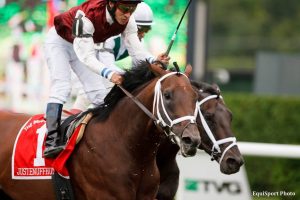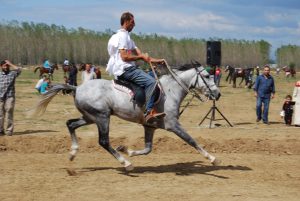Horses have been important to the Turks and Turkey for more than 5000 years.
First used as food they were then used in war as cavalry and draught animals, then in agriculture and for transport and now largely for leisure and sport.
They were first used as food in the form of meat and then as milk (in the form of soured and slightly fermented ‘kimiz’, better known internationally as the Mongolian ‘koumis’ but nonetheless a Turkish invention). The Turkish people became Islamicised during the eleventh century from which time, Islam had a positive effect on the attitude towards horses, the animal became culturally important and was a major element in the Turkish view of world domination.
Horses were heavily involved in international warfare during much of the nineteenth and twentieth centuries. In the nineteenth century these included the Crimean Wars in which the French and English fought on the Turkish side and in which perhaps the most famous of all cavalry actions – the Charge of the Light Brigade – took place and the Russo-Turkish Caucasian War.
In the twentieth century horses – notably of the Australia and New Zealand Light Horse Brigade — were used at Gallipoli where “English” and French forces were overwhelmingly defeated by Turkish forces during World War I.
The Turkoman horse, or Turkmene, was an Oriental horse breed from the steppes of Central Asia which is now extinct. They influenced many other horse breeds, including, possibly, the Thoroughbred horse and the popular Rahvan horse. Some horses bred in Iran and Turkmenistan today are still referred to as Turkoman, and have similar characteristics. 
The Turkoman horse was noted for its endurance. It had a slender body, similar to a greyhound. Although refined in appearance, the breed was actually one of the toughest in the world. They had a straight profile, long neck, and sloping shoulders. Their back was long, with sloping quarters and tucked-up abdomen. They had long and muscular legs.
The coat of a Turkomen horse could have been of any colour, and usually possessed a metallic sheen.
The Turkoman and the Arabian
A modern Arabian horse
Though both the Arabian horse and the Turkoman may have had a common ancestor in the oriental horse prototype, in their purest old forms they were very like one another in some ways and very different in others. Both had excellent speed and stamina. Both had extremely fine coats and delicate skin, unlike many horse breeds found in Europe. They both had large eyes, wide foreheads and tapering muzzles. They both came from very arid environments. Here, however, the similarities between the Turkoman of Central Asia and the Arabians of the desert lands of Central Arabia end, and the horses begin to diverge to suit their environments and the fighting styles of their breeders. Turkoman had small hooves. This was an adaptation to the steppes of the Central Asia, which largely consisted of a hard, rocky ground, covered with coarse sand, more like fine gravel and of stiff, parched vegetation. The Arabian had fairly large hooves for its size. In the Central Arabian Desert there is deep sand as well as hard terrain. A larger hoof is needed to cope with this type of terrain.
The back of the Turkoman, the Tekke Turkoman, and today in many cases, the Akhal-Teke, is much longer than that of the Arabian. The reason for this may likely to be that when riding long distances, the Turkoman was expected to trot, and the Arabian was not; the Bedouin tended to ride camels over long distances, leading their war horses, saving them for raiding, which was primarily done at the gallop.
turkish horses , turkish studs , gallop from turkey , Turkish gallops , Turkoman horses ,
turkish horses , turkish studs , gallop from turkey , Turkish gallops , Turkoman horses
turkish horses , turkish studs , gallop from turkey , Turkish gallops , Turkoman horses
turkish horses , turkish studs , gallop from turkey , Turkish gallops , Turkoman horses
turkish horses , turkish studs , gallop from turkey , Turkish gallops , Turkoman horses
turkish horses , turkish studs , gallop from turkey , Turkish gallops , Turkoman horses
turkish horses , turkish studs , gallop from turkey , Turkish gallops , Turkoman horses
turkish horses , turkish studs , gallop from turkey , Turkish gallops , Turkoman horses
turkish horses , turkish studs , gallop from turkey , Turkish gallops , Turkoman horses
turkish horses , turkish studs , gallop from turkey , Turkish gallops , Turkoman horses
turkish horses , turkish studs , gallop from turkey , Turkish gallops , Turkoman horses
turkish horses , turkish studs , gallop from turkey , Turkish gallops , Turkoman horses
turkish horses , turkish studs , gallop from turkey , Turkish gallops , Turkoman horses
turkish horses , turkish studs , gallop from turkey , Turkish gallops , Turkoman horses
turkish horses , turkish studs , gallop from turkey , Turkish gallops , Turkoman horses
turkish horses , turkish studs , gallop from turkey , Turkish gallops , Turkoman horses
turkish horses , turkish studs , gallop from turkey , Turkish gallops , Turkoman horses
turkish horses , turkish studs , gallop from turkey , Turkish gallops , Turkoman horses
turkish horses , turkish studs , gallop from turkey , Turkish gallops , Turkoman horses
turkish horses , turkish studs , gallop from turkey , Turkish gallops , Turkoman horses
turkish horses , turkish studs , gallop from turkey , Turkish gallops , Turkoman horses
turkish horses , turkish studs , gallop from turkey , Turkish gallops , Turkoman horses
turkish horses , turkish studs , gallop from turkey , Turkish gallops , Turkoman horses
turkish horses , turkish studs , gallop from turkey , Turkish gallops , Turkoman horses
turkish horses , turkish studs , gallop from turkey , Turkish gallops , Turkoman horses
turkish horses , turkish studs , gallop from turkey , Turkish gallops , Turkoman horses
turkish horses , turkish studs , gallop from turkey , Turkish gallops , Turkoman horses
turkish horses , turkish studs , gallop from turkey , Turkish gallops , Turkoman horses
turkish horses , turkish studs , gallop from turkey , Turkish gallops , Turkoman horses

